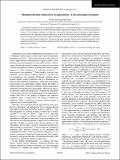Minimum thermal conductivity in superlattices: A first-principles formalism
Author(s)
Garg, Jivtesh; Chen, Gang
DownloadGarg-2013-Minimum thermal conductivity.pdf (229.5Kb)
PUBLISHER_POLICY
Publisher Policy
Article is made available in accordance with the publisher's policy and may be subject to US copyright law. Please refer to the publisher's site for terms of use.
Terms of use
Metadata
Show full item recordAbstract
The thermal conductivity of silicon-germanium superlattices is computed from density-functional perturbation theory using relaxation times that include both anharmonic and interface roughness effects. A decrease in the group velocity of low-frequency phonons in addition to the interface-disorder-induced scattering of high-frequency phonons drives the superlattice thermal conductivity to below the alloy limit. At short periods, interplay between decrease in group velocity and increase in phonon lifetimes with increase in superlattice period leads to a minimum in the cross-plane thermal conductivity. Increasing the mass mismatch between the constituent materials in the superlattice further lowers the thermal conductivity below the alloy limit, pointing to avenues for higher efficiency thermoelectric materials.
Date issued
2013-04Department
Massachusetts Institute of Technology. Department of Mechanical EngineeringJournal
Physical Review B
Publisher
American Physical Society
Citation
Garg, Jivtesh, and Gang Chen. "Minimum thermal conductivity in superlattices: A first-principles formalism." Phys. Rev. B 87, 140302(R) (April 2013). © 2013 American Physical Society
Version: Final published version
ISSN
1098-0121
1550-235X